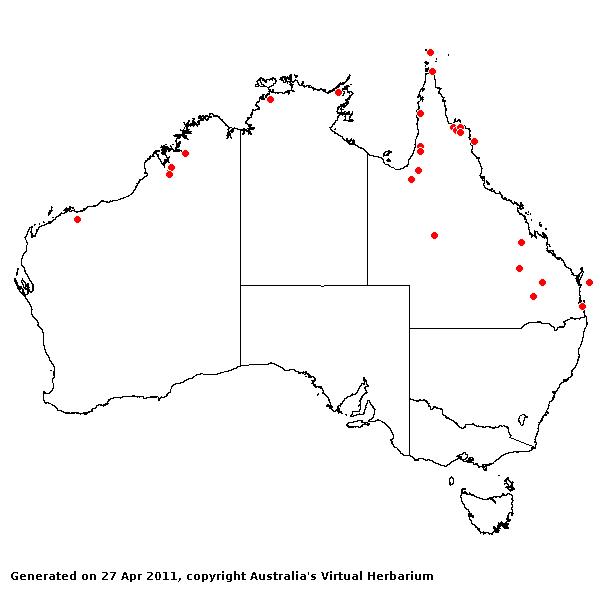Eriochloa fatmensis (Hochst. &
Steud.) Clayton.
Classification. (GPWG 2001) : Subfamily
Panicoideae. Paniceae.
Basionym and/or
Replacement Name: Panicum
fatmense Hochst. & Steud. in sched., Schimper It. Un.
:806 (1837).
Type of Basionym or
Protologue Information: HT: Schimper 806, Saudia Arabia: Mecca (P;
IT: K, L, MO, LE-TRIN-0545.04). herb. un. arab. nr. 806.
Recent synonyms:
Eriochloa decumbens F.M. Bailey , Queensland Agric. J. 1: 234
(1897).
Key references
(books and floras): [1878] G.Bentham, Flora Australiensis 7 (463 as Eriochloa
annulata var. acrotricha), [2002] D.Sharp & B.K.Simon, AusGrass,
Grasses of Australia.
Habit. Annual
or perennial. Culms erect or geniculately ascending or decumbent, 10–120 cm
tall. Ligule a fringe of hairs, 0.4–0.7 mm long. Leaf-blades 3–30 cm long, 2–10
mm wide. Leaf-blade surface smooth.
Inflorescence.
Inflorescence compound, a panicle of racemes. Racemes 3–10, 1–5 cm long.
Central inflorescence axis 3–20 cm long.
Spikelets.
Spikelets pedicelled. Fertile spikelets 2-flowered, the lower floret barren
(rarely male), the upper fertile, comprising 1 basal sterile florets,
comprising 1 fertile floret(s), without rachilla extension, lanceolate,
dorsally compressed, (2.5–)2.7–3–5 mm long.
Glumes. Glumes
thinner than fertile lemma. Upper glume elliptic, (2.5–)2.7–3–5 mm long,
membranous, without keels, 5 -nerved. Upper glume surface indumented. Upper
glume apex mucronate or awned. Florets. Basal sterile florets 1, barren,
without significant palea. Lemma of lower sterile floret 90 % of length of
spikelet, 5 -nerved, awned.
Fertile lemma 1.8–3 mm
long, without keel, 5 -nerved. Lemma apex mucronate. Median (principal) awn
0.3–1 mm long overall.
Continental
Distribution: Africa, Temperate Asia, Tropical Asia, and Australasia.
Australian
Distribution: Western Australia, Northern Territory, Queensland.
Western Australia:
Gardner, Dampier. Northern Territory: Darwin & Gulf, Victoria River,
Barkly Tableland. Queensland: Cook, Burke, Leichhardt, Wide Bay,
Moreton, Gregory North.
Notes.
Eriochloa decumbens is morphologically similar to E. procera,
having an acuminate and shortly awned upper glume and a decumbent habit. E.
procera has been limited to those specimens with acute spikelets and erect
habit. Bor (1960) placed E. decumbens as a synonym of E. nubica
(Steud.) Thell. Clayton (1982) placed E. nubica as a synonym of E.
fatmensis (Hochst. & Steud.) W.D. Clayton and his description and
drawing of this taxon could apply to Australian specimens that have tentatively
been identified as E. decumbens.
In tropical heaths,
tropical and subtropical rain forests, Brigalow forests, tropical and
subtropical sub-humid woodlands, coastal grasslands, and tropical sub-humid
grasslands. Flowers sporadically throughout the year but mostly Jan.-May.

